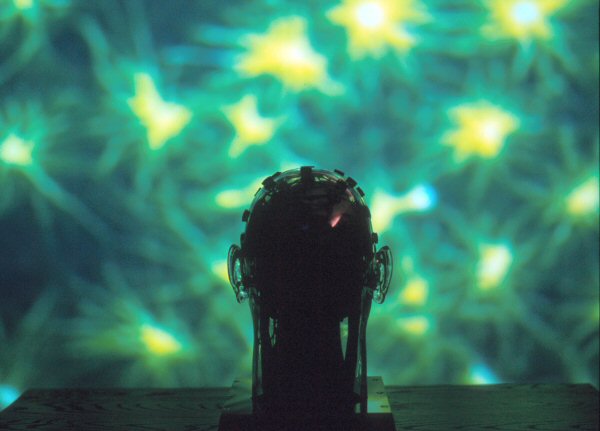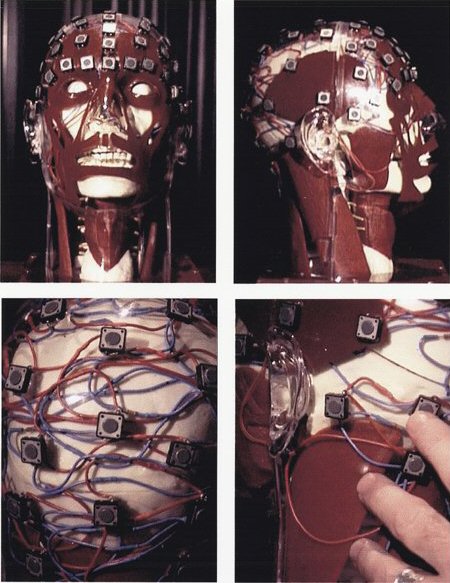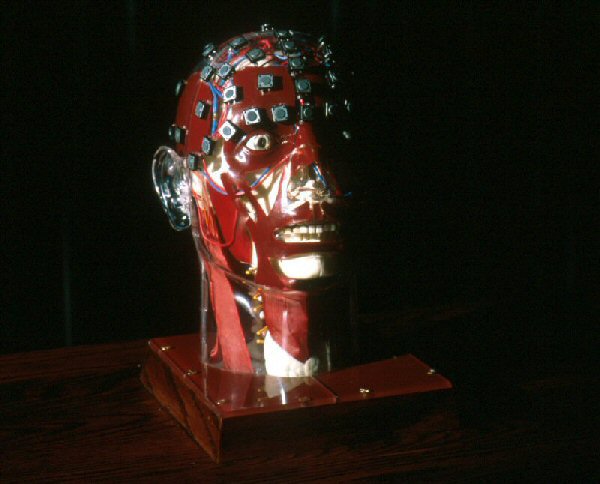Please wait a few moments while we process your request

Alan Dunning
Representations of the Body in Liquid Media Spaces
The Foundation supported Alan Dunning’s technical and conceptual research into developing an interface prototype that places the human body in a discursive and media space without relinquishing the body’s materiality.
A collaborative effort with leading scientists, the Einstein's Brain Project (1995-2001) comprises a series of immersive environments characterized by the use of feedback between the biological signals emitted by the participant (changes in brain waves, body temperature and such) and the display of data in the virtual universe. This time, Dunning will explore how biological signals travelling toward a computer module affect an external substance.
In the installation Madhouse (2001), which forms part of the Einstein's Brain Project (1995-2001), the participant alters an electromagnetic field emanating from an anatomical model of the human body and thereby triggers different media events (sound, video projections) in real time. To add a malleable physical layer to this interface, Dunning has isolated a liquid matter, a ferrofluid, which reacts to the changing strength of an electromagnetic field.
Ferrofluids, which NASA discovered in the sixties, are part liquid, part magnet with energy-conducting properties similar to motor oil. When this fluid is subjected to an electromagnetic field, the attractive forces of gravity, magnetism and surface tension shape the ferrofluid whose density changes proportionally. In medicine, ferrofluids are used to carry medications to specific locations of the body. Some scientists are investigating the use of ferrofluids to improve the readability of data generated by a magnetic resonance display device.
In Dunning’s prototype, a computer module is linked to electromagnets that alter the surface of the ferrofluid so as to generate patterns reflecting the biological data collected from the participant’s body. In line with his past projects, Dunning tries to evoke the body’s absorption into the media and abstract networks via an index that paradoxically reveals the body’s physical presence.
The findings of his ongoing research will be published and presented as a prototype at festivals and conferences. Once the technology is operational and the conceptual research is completed, the artist will integrate the device into installations, which he plans to exhibit in galleries in around 2003 and 2004.
A collaborative effort with leading scientists, the Einstein's Brain Project (1995-2001) comprises a series of immersive environments characterized by the use of feedback between the biological signals emitted by the participant (changes in brain waves, body temperature and such) and the display of data in the virtual universe. This time, Dunning will explore how biological signals travelling toward a computer module affect an external substance.
In the installation Madhouse (2001), which forms part of the Einstein's Brain Project (1995-2001), the participant alters an electromagnetic field emanating from an anatomical model of the human body and thereby triggers different media events (sound, video projections) in real time. To add a malleable physical layer to this interface, Dunning has isolated a liquid matter, a ferrofluid, which reacts to the changing strength of an electromagnetic field.
Ferrofluids, which NASA discovered in the sixties, are part liquid, part magnet with energy-conducting properties similar to motor oil. When this fluid is subjected to an electromagnetic field, the attractive forces of gravity, magnetism and surface tension shape the ferrofluid whose density changes proportionally. In medicine, ferrofluids are used to carry medications to specific locations of the body. Some scientists are investigating the use of ferrofluids to improve the readability of data generated by a magnetic resonance display device.
In Dunning’s prototype, a computer module is linked to electromagnets that alter the surface of the ferrofluid so as to generate patterns reflecting the biological data collected from the participant’s body. In line with his past projects, Dunning tries to evoke the body’s absorption into the media and abstract networks via an index that paradoxically reveals the body’s physical presence.
The findings of his ongoing research will be published and presented as a prototype at festivals and conferences. Once the technology is operational and the conceptual research is completed, the artist will integrate the device into installations, which he plans to exhibit in galleries in around 2003 and 2004.
Vincent Bonin © 2004 FDL
Related page:
 Alan Dunning
Alan DunningAlan Dunning lives in Calgary (Alberta, Canada) where he heads up the department of media arts and digital technologies at the Alberta College of Art.
External link:
Einstein Brain Project :
http://www.ucalgary.ca/~einbrain/
http://www.ucalgary.ca/~einbrain/









